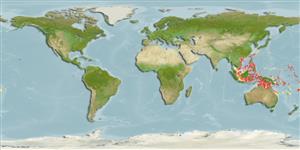>
Gobiiformes (Gobies) >
Gobiidae (Gobies) > Gobiinae
Etymology: Amblyeleotris: Greek, amblys = darkness + The name of a Nile fish, eleotris (Ref. 45335); biguttata: Name from Latin meaning two spots, for the prominent black spots on the chin.
More on author: Randall.
Environment: milieu / climate zone / kisaran kedalaman / distribution range
Ekologi
laut dasar (demersal); kisaran kedalaman 11 - 50 m (Ref. 57552). Tropical
Western Pacific: Solomon Islands and New Caledonia.
Size / Weight / umur
Kematangan: Lm ? range ? - ? cm
Max length : 10.4 cm TL jantan/; (Ref. 90102)
deskripsi pendek
Kunci identifiaksi (pengenalan) | Morfologi | Morfometrik
Duri punggung (Keseluruhan (total)) : 7; duri punggung lunak (Keseluruhan (total)) : 13; Duri dubur: 1; Sirip dubur lunak: 13; vertebrata, bertulang belakang: 25. Diagnosis: Dorsal rays VI+I, 13; anal rays I, 13; pectoral rays 19; pelvic fins joined by membrane to tips of fifth rays; pelvic frenum present; fourth pelvic ray longest; fifth pelvic ray branching twice. Longitudinal scale series 91-103; no median predorsal scales; scales on side of nape extending to above middle of opercle. Gill opening reaching forward to a vertical about two-thirds orbit diameter behind eye. Body depth 5.8-6.1 in SL; head length 3.6-3.8 in SL; caudal fin pointed and long, 2.2-2.6 in SL. Pale brown dorsally, white ventrally, with three indistinct brown bars on body, and a slightly oblique brown bar from nape across opercle; pale interspaces with small brown blotches, faintly interconnected; a pair of prominent black spots on chin; dorsal fins yellowish grey, the first dorsal with small irregular dark-edged pale blue spots and orange tipped spines, the second dorsal with a broad yellow border containing small dark-edged pale blue spots, the rays tipped with orange; caudal fin with a vertically elongate diffuse brown spot on base (Ref. 57552).
Body shape (shape guide): elongated; Cross section: circular.
The species inhabits silty sand areas and is associated with unidentified alpheid shrimp, where this species takes refuge in the shrimp's burrow (Ref. 57552).
Life cycle and mating behavior
Kematangan | Reproduksi, perkembang biakan | Pemijahan | telur-telur | Fecundity | Larva
Randall, J.E., 2004. Five new shrimp gobies of the genus Amblyeleotris from islands of Oceania. aqua, J. Ichthyol. Aquat. Biol. 8(2):61-78. (Ref. 57552)
Status IUCN Red List (Ref. 130435: Version 2025-1)
ancaman kepada manusia
Harmless
penggunaan manusia
Alat, peralatan
laporan khas
muat turun XML
Sumber internet
Estimates based on models
Preferred temperature (Acuan
123201): 25.8 - 29, mean 27.8 °C (based on 48 cells).
Phylogenetic diversity index (Acuan
82804): PD
50 = 0.5000 [Uniqueness, from 0.5 = low to 2.0 = high].
Bayesian length-weight: a=0.00724 (0.00339 - 0.01546), b=3.10 (2.92 - 3.28), in cm total length, based on LWR estimates for this (Sub)family-body shape (Ref.
93245).
Trophic level (Acuan
69278): 3.3 ±0.4 se; based on size and trophs of closest relatives
Daya lenting (Acuan
120179): Tinggi, Waktu penggandaan populasi minimum kurang dari 15 bulan (Preliminary K or Fecundity.).
Fishing Vulnerability (Ref.
59153): Low vulnerability (10 of 100).
🛈
